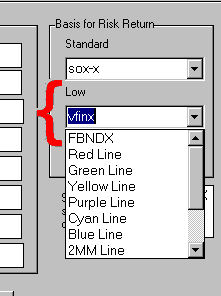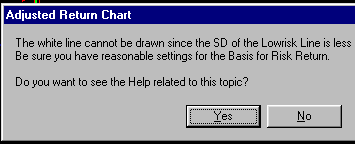Basis for Risk Return
Updated 01/31/14
 The concept is simple: For every unit of additional risk you get a unit of additional return.This is true in the broadest sense but note that the rule does not hold at the extremes:
|
In the Parameters Dialog Box | |
|
|
Click for a more complete discussion
of setting parameters. The following discussion concerns the settings of the "Basis
for Risk Return" box within the Parameter Dialog. There are two selection boxes. Click on the down arrows to see the choices. Pick two issues, indices, or averages to define the Basis for Risk Return, the Standard basis and the Low basis (highlighted to the left by a red bracket { . These choices define the risk return ratio for a line drawn on the J and 2 Charts' white line calculation. You may key in your own symbol for the Standard or Low basis, or pick the from the dropdown list for each. VFINX (the classic Vanguard S&P-500 fund) occupies the broad middle of equity averages. FSHBX is a typical short-term bond fund. Thus, these two are good choices as one of the parameters. VFINX/FSHBX might be the Standard/Low parameter when judging very volatile stocks or volatile funds like HITECH mutual funds. SOX-X is a volatile technology index)VFINX would be a good typical choice for the Standard parameter when judging low volatility INCOMEQ mutual funds. FSHBX is a good choice for the Low basis |
|
Error Message
|
||
Applying Risk/Return to InvestingMutual Fund Risk and ReturnThe chart shows a scatter diagram of risk (Standard Deviation, X-axis) and return (Y-axis). Key benchmarks are highlighted. The points are for the Fidelity mutual funds that existed for the period 9/1/88 - 5/1/98. The risk/return of the S&P 500 (actually we used the SD and return of VFINX) falls in the middle of the spectrum. A short-term bond fund like FSHBX falls at the conservative end. A technology sector fund like FSELX falls at the aggressive end. We drew a red line using linear regression through the points. Mutual funds above the line would be considered to have "good" risk-adjusted return. Mutual funds below the line have "bad" risk-adjusted return. |
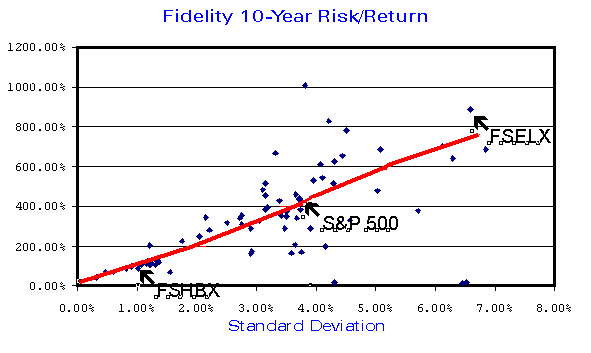 Note that points fall along a line drawn between the risk and return of FSHBX (a short-term bond funds) and the SP& 500 (Actually VFINX). FastTrack's J and 2 Chart white lines are drawn based, by default, on these two points. However, for international mutual funds, sector funds, and other mutual funds that do not correlate highly with the S&P 500, the white line would be inappropriate unless you change the issues that define the end points of the line. See parameter setting. |
|
Stock Risk and ReturnThe chart shows a scatter diagram of risk (Standard Deviation) on the X-axis and return (Y-axis). Key benchmarks are highlighted. The points are for the FastTrack stocks family ALL-NYSE that existed for the period 9/1/88-5/1/98. The diagram has more points, and the SD and returns span a greater range. You don't see the extreme range in mutual funds because funds average the performance of many stocks. The red Mutual Funds risk/return regression line illustrates the risk-adjusted appeal of mutual funds. Mutual funds are less volatile, yet offer good returns for the considering risk. |
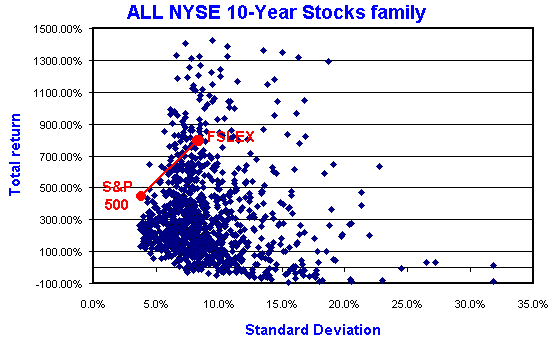 It is MUCH harder to pick a good risk/return performer in stocks than in mutual funds. Mutual fund's appeal to the typical investor because the chances of getting burned are much less. However, it you can pick a few hot stocks, then the potential for return is much higher with stocks. |
|
S&P 500 StocksFor the decade of the 1990's, the large companies of the S&P 500 haven't been as volatile as the broader family, ALL-NYSE stocks (chart above). While it is unlikely that the S&P 500 stocks will continue this advantage, it is likely that you will do better with issues that have a FastTrack Standard Deviation under 10% . . . remember that return prediction at risk extremes of is impossible. Beyond an SD=10.0%, DO NOT BUY and HOLD. These are speculative issues that must be actively managed. Take profits and cut losses. |
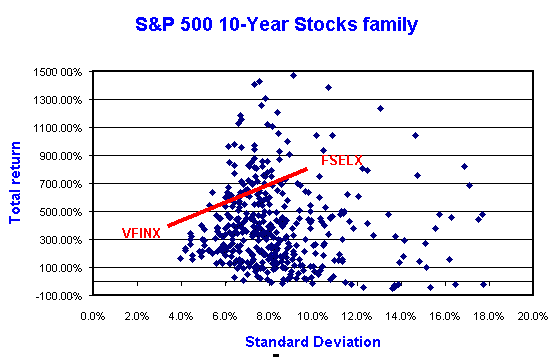 |
|
